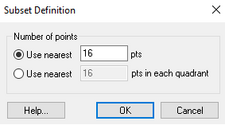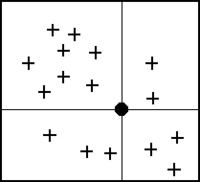GMS:Subset Definition: Difference between revisions
No edit summary |
No edit summary |
||
| Line 2: | Line 2: | ||
In the [[GMS:Inverse Distance Weighted|''IDW Interpolation Options'']] dialog, an option is available for using a subset of the data points (as opposed to all of the available data points) in the computation of the nodal function coefficients and in the computation of the interpolation weights. Using a subset of the data points drops distant points from consideration since they are unlikely to have a large influence on the nodal function or on the interpolation weights. In addition, using a subset can speed up the computations since less points are involved. | In the [[GMS:Inverse Distance Weighted|''IDW Interpolation Options'']] dialog, an option is available for using a subset of the data points (as opposed to all of the available data points) in the computation of the nodal function coefficients and in the computation of the interpolation weights. Using a subset of the data points drops distant points from consideration since they are unlikely to have a large influence on the nodal function or on the interpolation weights. In addition, using a subset can speed up the computations since less points are involved. | ||
If the ''Use subset of points'' option is chosen, the '''Subsets''' button can be used to bring up the ''Subset Definition'' dialog. Two options are available for defining which points are included in the subset. In one case, only the nearest ''N'' points are used. In the other case, only the nearest ''N'' points in each quadrant are used as | If the ''Use subset of points'' option is chosen, the '''Subsets''' button can be used to bring up the ''Subset Definition'' dialog. Two options are available for defining which points are included in the subset. In one case, only the nearest ''N'' points are used. In the other case, only the nearest ''N'' points in each quadrant are used as illustrated in the figure below. This approach may give better results if the data points tend to be clustered. | ||
:[[Image:idw_fig1.png|thumb|none|200 px|''The Four Quadrants Surrounding an Interpolation Point.'']] | :[[Image:idw_fig1.png|thumb|none|200 px|''The Four Quadrants Surrounding an Interpolation Point.'']] | ||
Revision as of 17:08, 5 August 2016
In the IDW Interpolation Options dialog, an option is available for using a subset of the data points (as opposed to all of the available data points) in the computation of the nodal function coefficients and in the computation of the interpolation weights. Using a subset of the data points drops distant points from consideration since they are unlikely to have a large influence on the nodal function or on the interpolation weights. In addition, using a subset can speed up the computations since less points are involved.
If the Use subset of points option is chosen, the Subsets button can be used to bring up the Subset Definition dialog. Two options are available for defining which points are included in the subset. In one case, only the nearest N points are used. In the other case, only the nearest N points in each quadrant are used as illustrated in the figure below. This approach may give better results if the data points tend to be clustered.
Related Topics
GMS – Groundwater Modeling System | ||
|---|---|---|
| Modules: | 2D Grid • 2D Mesh • 2D Scatter Point • 3D Grid • 3D Mesh • 3D Scatter Point • Boreholes • GIS • Map • Solid • TINs • UGrids | |
| Models: | FEFLOW • FEMWATER • HydroGeoSphere • MODAEM • MODFLOW • MODPATH • mod-PATH3DU • MT3DMS • MT3D-USGS • PEST • PHT3D • RT3D • SEAM3D • SEAWAT • SEEP2D • T-PROGS • ZONEBUDGET | |
| Aquaveo | ||

